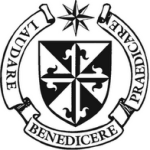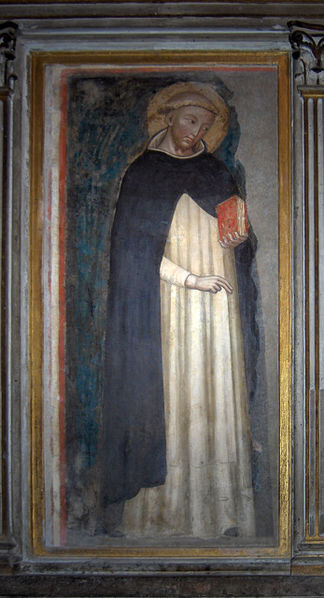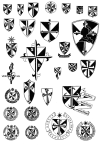Dominican Cross
The order was founded by St. Dominic to preach to the Cathars of southern France in the early 13th century. The French connection is seen in the Fleur de lis on the end of each cross limb.
There are Roman Catholic Dominican Orders and also Anglican Dominican Orders.
By Paul Harding
with thanks to Sean Wright for his inspiration
and Sister Karina for additional information and images.
The black and white of the emblem reflects the characteristic Dominican habit, largely unchanged for 800 years: a long white tunic, contrasting with a black cloak, cappa (shoulder cape) and/or scapular.
The black and white represents truth over heresy. In addition, the white reflects the joy and the purity of Christ, and the black reminds servants of the Lord of their humility and obligation for penance. These black cloaks led to the term 'Blackfriars', as opposed to Whitefriars (Carmelites) or Greyfriars (Franciscans).
Click the painting of St. Dominic for a larger view and notice the extended fingers of the right hand. When making the Sign of the cross, one or two fingers are used, with or without the thumb. When two fingers are used, this symbolises the two wills and two natures in Jesus Christ; human and divine.
The two fingers could also relate to the two colours used in the Dominican cross, but as the Chaplain of The Anglican Order of Preachers advises us:

Order of Preachers emblem (curia.op.org)
"The Dominica Cross comes from the Torch of Truth, a symbol of the Dominican Order, often shown being carried in the mouth of a little black and white dog. It originates in a dream St. Dominic's mother had when she was pregnant with the Saint: she dreamed of her child as a little black and white dog, illuminating the world by carrying a torch in his mouth."
Curious that the dog should be black and white; colours later adopted by the Order. The dog carrying the torch in its mouth symbolises travelling, spreading the Gospel about the Light of Christ.
Sister Karina of the Dominican Sisters of Springfield, Illinois, (springfieldop.org) points out that:
"the travelling dog also relates to the Dominicans being itinerant preachers. They went from place to place preaching and then returned to their convents. Unlike most of the monastic orders, Dominicans do not make a vow of stability. The men can be assigned to any province in the world, depending on need."
Dogs are often seen to be faithful followers of their master. And there's a pun on the term 'Dominican': The Latin for 'Lord' is Domini, and 'dog' is canes, hence 'Dogs of the Lord'.
Sr. Karina also kindly sent the collection of Dominican Crosses shown below. Click any image to enlarge.
A motto common to many of these emblems is 'Laudare, Benedicere, Praedicare': To praise, to bless and to preach (from the Dominican Missal, Preface of the Blessed Virgin Mary).
The seal of the Assumption College in Massachusetts looks similar to the Dominican Cross, but has a couple of significant differences. Firstly, colour — the College colours are blue and white; unlike the black and white trademark of the Order of Preachers. Secondly, the College emblem lacks the gyronny in the centre of the cross. Instead, we see there the traditional Augustinian coat of arms.
In heraldry a two-coloured cross such as this is called a Gyronny Cross and gives a 3-dimensional illusion. There's another, more subtle, meaning in the gyronny; not the black and white, but the word 'gyronny' itself.
A gyro, as any culinary expert will attest, describes the Greek method of preparing a lamb dish. 'Gyro' is an old Greek word for 'rotate', and used to describe the process of roasting meat on a spit, particularly lamb. Jesus, of course, is referred to as the Lamb of God.
The Dominican Cross shouldn't be confused with the Greek Cross of the Dominican Republic.












